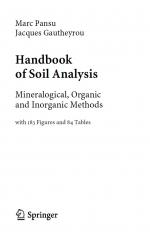Добрый день, Коллеги. Важное сообщение, просьба принять участие. Музей Ферсмана ищет помощь для реставрационных работ в помещении. Подробности по ссылке
Handbook of soil analysis. Minerelogical, organic and inorganik methods
This new book by Marc Pansu and Jacques Gautheyrou provides a synopsis of the analytical procedures for the physicochemical analysis of soils. It is written to conform to analytical standards and quality control. It focuses on mineralogical, organic and inorganic analyses, but also describes physical methods when these are a precondition for analysis. It will help a range of different users to choose the most appropriate method for the type of material and the particular problems they have to face. The compiled work is the product of the experience gained by the authors in the laboratories of the Institute of Research for Development (IRD) in France and in tropical countries, and includes an extensive review of the literature. The reference section at the end of each chapter lists source data from pioneer studies right up to current works, such as, proposals for structural models of humic molecules, and itself represents a valuable source of information.
IRD soil scientists collected data on Mediterranean and tropical soils in the field from West and North Africa, Madagascar, Latin America, and South East Asia. Soil materials from these regions are often different from those found in temperate zones. As their analysis brought new problems to light, it was essential to develop powerful and specific physicochemical methods. Physicists, chemists and biologists joined forces with IRD soil scientists to contribute knowledge from their own disciplines thereby widening its scope considerably. This work is the fruit of these experiments as applied to complex systems, involving soils and the environment.
The methodological range is particularly wide and each chapter presents both simple analyses and analyses that may require sophisticated equipment, as well as specific skills. It is aimed both at teams involved in practical field work and at researchers involved in fundamental and applied research. It describes the principles, the physical and chemical basis of each method, the corresponding analytical procedures, and the constraints and limits of each. The descriptions are practical, easy to understand and implement. Summary tables enable a rapid overview of the data. Complex techniques are explained under the heading ‘Principle’ and concrete examples of methods include: spectra (near and far IR, UV-visible, 1H-NMR, 13C- NMR, ESR, ICP-AES, ICP-MS, X-ray fluorescence, EDX or WDX microprobe, neutron activation analysis), diffractograms (XRD, electron microdiffraction), thermograms (DTA, DTG, TGA), chromatograms (GPC, HPLC, ionic chromatography, exclusion chromatography), electrophoregrams, ion exchange methods, electrochemistry, biology, different physical separation techniques, selective dissolutions, and imagery.
The book will be valuable not only for researchers, engineers, technicians and students in soil science, but also for agronomists and ecologists and others in related disciplines, such as, analytical physical chemistry, geology, climatology, civil engineering and industries associated with soil. It is a basic work whose goal is to contribute to the scientific analysis of the environment. The methodologies it describes apply to a wide range of bioclimatic zones: temperate, arid, subtropical and tropical. As with the previous books by the same authors (Pansu, Gautheyrou and Loyer, 1998, Masson, Paris, Milan, Barcelona; Pansu, Gautheyrou and Loyer, 2001, Balkema, Lisse, Abington, Exton, Tokyo), this new book represents a reference work for our laboratories. We are confident its originality and ease of use will ensure its success.
Alain Aventurier, Director of Analytical Laboratories of CIRAD1
Christian Feller, Director of Research at IRD2
Pierre Bottner, Director of Research at CNRS3




